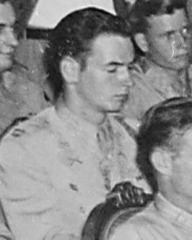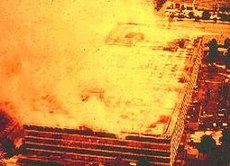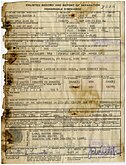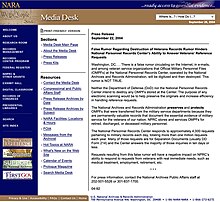
The Purple Heart (PH) is a United States military decoration awarded in the name of the president to those wounded or killed while serving, on or after 5 April 1917, with the U.S. military. With its forerunner, the Badge of Military Merit, which took the form of a heart made of purple cloth, the Purple Heart is the oldest military award still given to U.S. military members. The National Purple Heart Hall of Honor is located in New Windsor, New York.

The United States Department of Veterans Affairs (VA) is a Cabinet-level executive branch department of the federal government charged with providing lifelong healthcare services to eligible military veterans at the 170 VA medical centers and outpatient clinics located throughout the country. Non-healthcare benefits include disability compensation, vocational rehabilitation, education assistance, home loans, and life insurance. The VA also provides burial and memorial benefits to eligible veterans and family members at 135 national cemeteries.

Overland is a city in St. Louis County, Missouri, United States. The population was 16,062 at the 2010 census.

Audie Leon Murphy was an American soldier, actor, and songwriter. He was one of the most decorated American combat soldiers of World War II. He received every military combat award for valor available from the United States Army, as well as French and Belgian awards for heroism. Murphy received the Medal of Honor for valor that he demonstrated at the age of 19 for single-handedly holding off a company of German soldiers for an hour at the Colmar Pocket in France in January 1945, before leading a successful counterattack while wounded and out of ammunition.

Controversy over George W. Bush's military service in the Air National Guard was an issue that first gained widespread public attention during the 2004 presidential campaign. The controversy centered on Texas Air National Guard, why he lost his flight status, and whether he fulfilled the requirements of his military service contract.

The Republic of Vietnam Gallantry Cross also known as the Vietnamese Gallantry Cross or Vietnam Cross of Gallantry is a military decoration of the former Government of South Vietnam. The medal was created on August 15, 1950, and was awarded to military personnel, civilians, and Armed Forces units and organizations in recognition of deeds of valor or heroic conduct while in combat with the enemy.

A military discharge is given when a member of the armed forces is released from their obligation to serve. Each country's military has different types of discharge. They are generally based on whether the persons completed their training and then fully and satisfactorily completed their term of service. Other types of discharge are based on factors such as the quality of their service, whether their service had to be ended prematurely due to humanitarian or medical reasons, whether they had been found to have drug or alcohol dependency issues and whether they were complying with treatment and counseling, and whether they had demerits or punishments for infractions or were convicted of any crimes. These factors affect whether they will be asked or allowed to re-enlist and whether they qualify for benefits after their discharge.

The National Personnel Records Center fire of 1973, also known as the 1973 National Archives fire, was a fire that occurred at the Military Personnel Records Center (MPRC) in the St. Louis suburb of Overland, Missouri, from July 12–16, 1973.
The National Personnel Records Center(s) (NPRC) is an agency of the National Archives and Records Administration, created in 1966. It is part of the United States National Archives federal records center system and is divided into two large Federal Records Centers located in St. Louis, Missouri, and Valmeyer, Illinois. The term "National Personnel Records Center" is often used to describe both the physical Military Personnel Records Center facility and as a broader term for all records centers in the St. Louis area. To differentiate, the broader collection is occasionally called the "National Personnel Records Centers".
During John Kerry's candidacy in the 2004 U.S. presidential campaign, a political issue that gained widespread public attention was Kerry's Vietnam War record. In television advertisements and a book called Unfit for Command, co-authored by John O'Neill and Jerome Corsi, the Swift Boat Veterans for Truth (SBVT), a 527 group later known as the Swift Vets and POWs for Truth, questioned details of his military service record and circumstances relating to the awarding of his combat medals. Their campaign against Kerry's presidential bid received widespread publicity, but was later discredited and gave rise to the neologism "swiftboating", to describe an unfair or untrue political attack. Defenders of Kerry's service record, including former crewmates, stated that allegations made by SBVT were false.

The United States Office of Special Counsel (OSC) is a permanent independent federal investigative and prosecutorial agency whose basic legislative authority comes from four federal statutes: the Civil Service Reform Act, the Whistleblower Protection Act, the Hatch Act, and the Uniformed Services Employment and Reemployment Rights Act (USERRA). OSC's primary mission is the safeguarding of the merit system in federal employment by protecting employees and applicants from prohibited personnel practices (PPPs), especially reprisal for "whistleblowing." The agency also operates a secure channel for federal whistleblower disclosures of violations of law, rule, or regulation; gross mismanagement; gross waste of funds; abuse of authority; and substantial and specific danger to public health and safety. In addition, OSC issues advice on the Hatch Act and enforces its restrictions on partisan political activity by government employees. Finally, OSC protects the civilian employment and reemployment rights of military service members under USERRA. OSC has around 140 staff, and the Special Counsel is an ex officio member of Council of Inspectors General on Integrity and Efficiency (CIGIE), an association of inspectors general charged with the regulation of good governance within the federal government.
The military career of John Kerry occurred during the Vietnam War. Kerry served as a Lieutenant in the United States Navy during the period from 1966 to 1970. His only tour in Vietnam was four months as officer in charge of a Swift boat in 1969. Kerry received several combat medals during this tour, including the Silver Star, Bronze Star, and three Purple Hearts. Kerry's military record received considerable attention during his political career, especially during his unsuccessful 2004 bid for the presidency.
The DD Form 214, Certificate of Release or Discharge from Active Duty, generally referred to as a "DD 214", is a document of the United States Department of Defense, issued upon a military service member's retirement, separation, or discharge from active duty in the Armed Forces of the United States.
A service record is a collection of either electronic or printed material which provides a documentary history of a person's activities and accomplishments while serving as a member of a given organization. Service records are most often associated with the military, but are commonly found in other groups, such as large corporations or for use by employees of a civilian government.

The Missouri Air National Guard (MO ANG) is the aerial militia of the State of Missouri, United States of America. It is, along with the Missouri Army National Guard, an element of the Missouri National Guard.
The U.S.–Russia Joint Commission on POWs/MIAs (USRJC) was established in 1992 by the presidents of the United States and the Russian Federation, George H. W. Bush and Boris Yeltsin. The USRJC was established to determine the fates of the United States's and the Soviet Union's unaccounted-for service personnel from World War II, the Korean War, the Cold War, Afghanistan and the Vietnam War, Laos and Cambodia.

Michael Joseph Daly was an Irish-American United States Army infantry officer who received the United States military's highest decoration for valor—the Medal of Honor—for his actions in World War II. He received the medal for single-handedly eliminating 15 German soldiers including a German patrol, and destroying three machine-gun nests.

In the United States, the National Archives facilities are facilities and buildings housing the research and agency services of the country's National Archives and Records Administration. Within the organization of the National Archives, the upkeep of its facilities falls under the National Archives Facilities and Property Management Office.

The Official Military Personnel File (OMPF), known as a 201 File in the U.S. Army, is an Armed Forces administrative record containing information about a service member's history, such as:
The Demobilized Personnel Records Center (DPRC) was an installation of the United States Army which operated in St. Louis, Missouri, from 1945 to 1956. The facility was housed in the former Goodfellow ordnance plant in St. Louis and became the central repository for all service records of discharged service members of the United States Army.


















